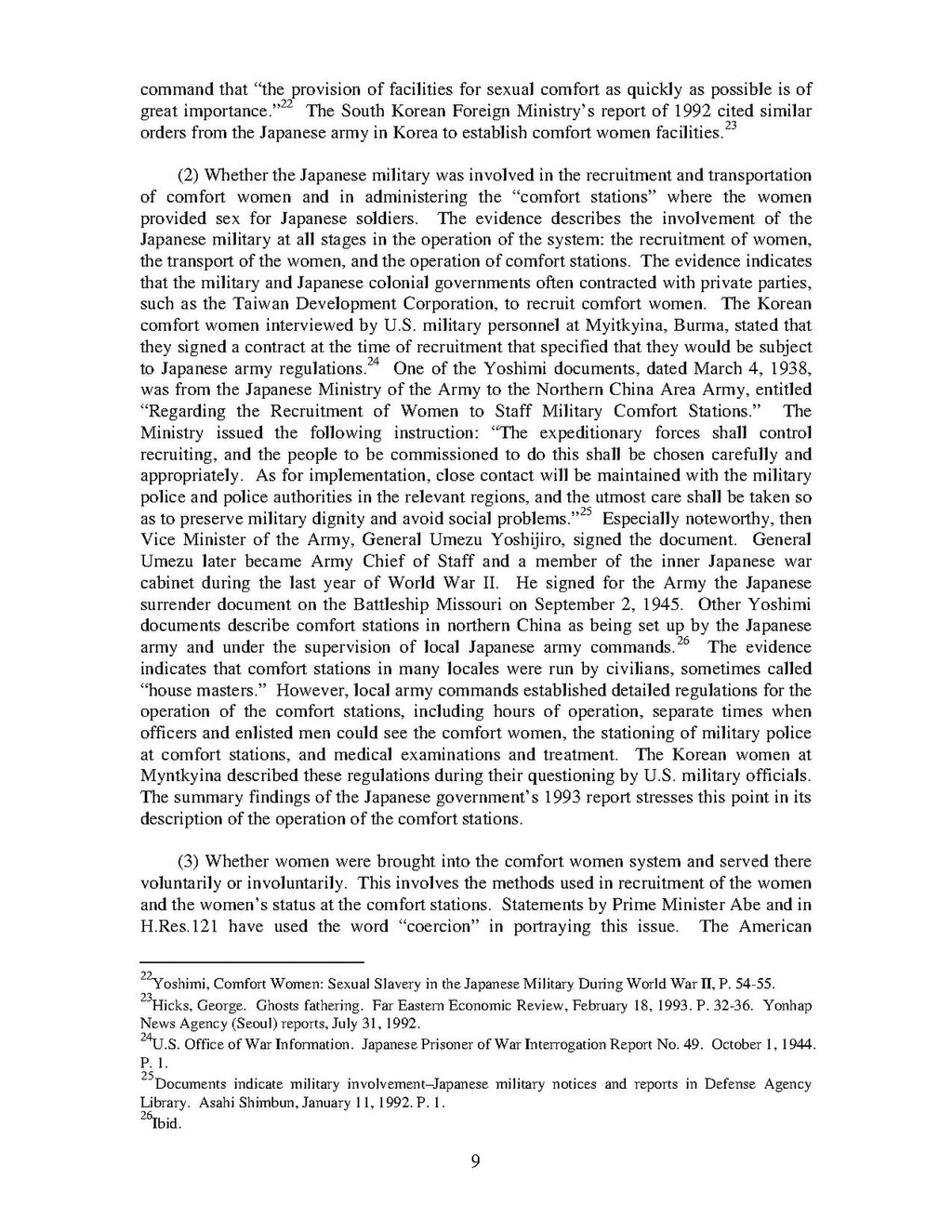command that “the provision of facilities for sexual comfort as quickly as possible is of great importance.”[1] The South Korean Foreign Ministry’s report of 1992 cited similar orders from the Japanese army in Korea to establish comfort women facilities.[2]
(2) Whether the Japanese military was involved in the recruitment and transportation of comfort women and in administering the “comfort stations” where the women provided sex for Japanese soldiers. The evidence describes the involvement of the Japanese military at all stages in the operation of the system: the recruitment of women, the transport of the women, and the operation of comfort stations. The evidence indicates that the military and Japanese colonial governments often contracted with private parties, such as the Taiwan Development Corporation, to recruit comfort women. The Korean comfort women interviewed by U.S. military personnel at Myitkyina, Burma, stated that they signed a contract at the time of recruitment that specified that they would be subject to Japanese army regulations.[3] One of the Yoshimi documents, dated March 4, 1938, was from the Japanese Ministry of the Army to the Northern China Area Army, entitled “Regarding the Recruitment of Women to Staff Military Comfort Stations.” The Ministry issued the following instruction: “The expeditionary forces shall control recruiting, and the people to be commissioned to do this shall be chosen carefully and appropriately. As for implementation, close contact will be maintained with the military police and police authorities in the relevant regions, and the utmost care shall be taken so as to preserve military dignity and avoid social problems.”[4] Especially noteworthy, then Vice Minister of the Army, General Umezu Yoshijiro, signed the document. General Umezu later became Army Chief of Staff and a member of the inner Japanese war cabinet during the last year of World War II. He signed for the Army the Japanese surrender document on the Battleship Missouri on September 2, 1945. Other Yoshimi documents describe comfort stations in northern China as being set up by the Japanese army and under the supervision of local Japanese army commands.[5] The evidence indicates that comfort stations in many locales were run by civilians, sometimes called “house masters.” However, local army commands established detailed regulations for the operation of the comfort stations, including hours of operation, separate times when officers and enlisted men could see the comfort women, the stationing of military police at comfort stations, and medical examinations and treatment. The Korean women at Myntkyina described these regulations during their questioning by U.S. military officials. The summary findings of the Japanese government’s 1993 report stresses this point in its description of the operation of the comfort stations.
(3) Whether women were brought into the comfort women system and served there voluntarily or involuntarily. This involves the methods used in recruitment of the women and the women’s status at the comfort stations. Statements by Prime Minister Abe and in H.Res. 121 have used the word “coercion” in portraying this issue. The American
- ↑ Yoshimi, Comfort Women: Sexual Slavery in the Japanese Military During World War II, P. 54–55.
- ↑ Hicks, George. Ghosts fathering. Far Eastern Economic Review, February 18, 1993. P. 32–36. Yonhap News Agency (Seoul) reports, July 31, 1992.
- ↑ U.S. Office of War Information. Japanese Prisoner of War Interrogation Report No. 49. October 1, 1944. P. 1.
- ↑ Documents indicate military involvement—Japanese military notices and reports in Defense Agency Library. Asahi Shimbun, January 11, 1992. P. 1.
- ↑ Ibid.
9
